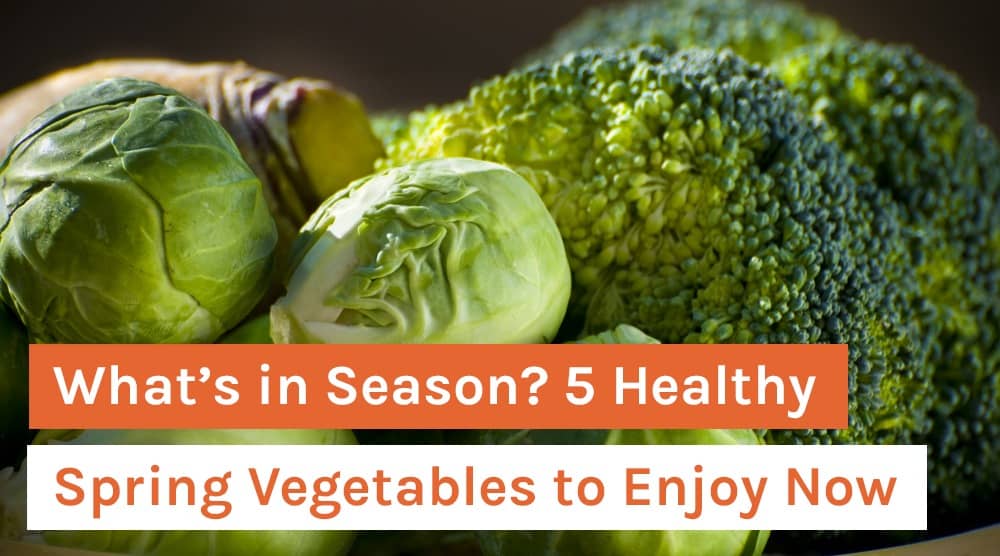What’s in Season? 5 Healthy Spring Vegetables to Enjoy Now
In a hurry? Click here to read the Article Summary...
We made it through the bitter winter and now spring is upon us. Spring is traditionally the time of re-birth, growth, and a fresh new start. If you spent a little too much time “hibernating” through the winter, spring is also the perfect time to focus on getting your body “tuned up” through healthier eating habits.
With the warmer weather comes the first home-grown vegetables of the season − the cornerstone of any healthy eating regimen. Whether you’re tending to your own garden or taking advantage of your local farmer’s market, now is the time to dive in to spring’s bounties.
Here is a rundown of some of the most popular spring-time produce and why NOW is the best time to eat them for your health.
Why Eat What’s in Season?
 The truth is that our modern form of agriculture, with pesticide spraying, genetically modified crops, and over-tilling the soil, has wreaked havoc on the nutritional value of most common crops over the last 50 years.
The truth is that our modern form of agriculture, with pesticide spraying, genetically modified crops, and over-tilling the soil, has wreaked havoc on the nutritional value of most common crops over the last 50 years.
It’s a sad fact that the fruits and veggies prior to the 1950s contained way more nutritional value than the crops of today − even when you buy organic.
A comprehensive analysis of 43 typical crops grown between 1950 and 1999 conducted by the Biochemical Institute at the University of Texas and the Bio-Communications Institute in Wichita, Kansas, found that “reliable declines” in calcium, phosphorus, iron, vitamins B2, vitamin C and protein occurred over those 50 years for the crops they studied.
The researchers also concluded that the decline was in direct correlation with certain agricultural practices designed to improve traits such as size, growth time, and pest resistance − but not nutritional value.
There is some good news to come out of all this, however. Studies have also shown that the nutritional difference is wide between commercially-grown produce that is picked before it has had a chance to ripen (and then shipped hundreds of miles to the grocery store) and those that are allowed to ripen on the vine or on the ground and then shipped just a short distance before being offered and consumed.
They have also found that heirloom varieties of common crops like potatoes and carrots really pack a nutritional punch. For example, heirloom varieties of blue corn contain 99.5 milligrams of phytonutrients compared to commercially grown white corn, which has 1.54 milligrams of phytonutrients.
What all this means is that it is healthier, by leaps and bounds, for you to eat seasonally and eat locally as much as possible!
In Season Now: The Top 5 Powerhouse Spring Veggies
Although seasonal springtime crops will vary geographically, the following varieties are ready to be consumed in the spring across much of the U.S. If you cannot grow your own, that’s okay!
Help support your local farmer by paying a visit to your area’s farmer’s market. Just make sure that what you buy is organic and be sure to try out the heirloom varieties whenever you get a chance.
Remember that heirlooms may also represent some of the last traditional seed lines out there, as more and more commercial varieties are being grown through genetically-modified seeds, some of which have a “self-destruct” mechanism built into them.
This means that the farmer must purchase those same seeds year after year. With many locally-kept heirloom varieties, however, seeds can be harvested for the future the way nature intended them to… from growing plants, year after year.
#1. Asparagus.
Asparagus contains many good-for-you nutrients, including flavonoids quercetin and steroidal saponin. Quercetin has been linked to a reduced risk of heart disease and is also known for its anti-cancer effects as well as being a neuro-protectant.
Saponins are lesser-known flavonoids, which have been shown to play a role in immune system function and the regulation of inflammatory responses.
Asparagus is also high vitamin K and folate, two nutritional elements that the body needs for many functions. According to nutritional scientists, the best way to maintain all the wonderful nutritional components of your asparagus is to lightly steam it for no more than 3 minutes.
#2. Broccoli.
Broccoli is of the “cruciferous” vegetable family. All cruciferous vegetables (especially broccoli sprouts) contain the super-antioxidant sulforaphane, which many studies have confirmed contains anti-cancer effects, even against cancer stem cells.
Broccoli can also help support digestive health. Besides its high fiber content, the sulforaphane in broccoli also contains isothiocyanates (ITCSs) which help to protect the stomach lining from Helicobacter pylori overgrown in that area.
Broccoli also contains about a dozen other healthy nutrients, including vitamin C, vitamin B6, potassium, zinc, calcium, and selenium.
The best way to prepare fresh broccoli is to lightly steam for about 5 minutes. Also, note that broccoli is a “goitrogen,” so if you have a thyroid condition, it’s best to speak with your natural health practitioner about consuming it to allay any concerns.
#3. Brussels Sprouts.
Brussels sprouts seem to be all the rage these days, even showing up as the “appetizer of choice” at trendy restaurants and gastropubs. This is for good reason. They are absolutely delicious when sliced and lightly sautéed with real grass-fed butter and a little chopped garlic.
Nutrition-wise, Brussels sprouts are at the top of the list as well. They contain some unique properties, including DNA protection (through the blockage of certain enzymes, say researchers) and the phytonutrient glucosinolate, which has been shown to have cancer-protective effects.
Brussels sprouts are also very high in vitamin K, vitamin C and fiber. The particular kind of fiber in Brussels sprouts appears to be kinder to the digestive process than other cruciferous vegetables.
Also unlike other cruciferous vegetables, some studies have shown that Brussels sprouts may not have as much of an effect on thyroid function as broccoli, cabbage, cauliflower, and other cruciferous vegetables.
A report published in the journal Human and Experimental Toxicology found that inclusion of cooked Brussels sprouts into the diets of healthy individuals for 4 weeks had no effect on their thyroid. It should be noted, however, that this test was not done on individuals who already had imbalanced thyroid function.
Nevertheless, this study, and others, has led some experts to conclude that cooked Brussels sprouts may be a safe and super-healthy vegetable for those with thyroid conditions such as hypo- or hyperthyroidism.
For a different and decidedly delicious salad option, check out our Brussels Sprouts Sunshine Salad recipe.
#4. Beets.
Beets contain betalains and vulgaxanthins, unique phytonutrients that have strong antioxidant, anti-inflammatory, and detoxification effects. Regarding detoxing, beets really shine.
They can help support “Phase 2 detoxification,” which aids in glutathione production. Because of this, studies have also shown that consuming beets may protect against radiation exposure and poisoning.
Beets can be boiled, steamed, shredded, and eaten raw or juiced along with some lime, green apple, leafy greens, and a little ginger for a refreshing morning detox and energizer.
For a fun snack or side dish idea, try these Colorful Beetroot Chips.
#5. Dandelion.
Wait… do you mean those weeds with the yellow flowers that are taking over my backyard? You got it! Dandelions spread a wide net. They grow just about anywhere in the U.S. beginning in mid-springtime and can pop up (whether you want them to or not) throughout the summer.
What you may not know is that dandelion is not just a pesky weed. It’s a true powerhouse of nutrition!
Dandelion root and leaves contain calcium, vitamin A, antioxidants, and fiber. Dandelion also helps to cleanse the liver and kidneys, and studies show they have benefits for those with diabetes as well as those with stomach conditions and urinary tract disorders.
It should also be noted that dandelion has been known to work on the bowels and can have a laxative effect. Dandelion may also interfere with antibiotic absorption. If you are unsure, talk to your healthcare provider.
Other Veggies in Season
Additional vegetables you may find at your local farmer’s market (or in your own backyard) right now that pack a nutritional punch are:
- carrots
- cabbage
- bok choi
- artichoke (Western states)
- radish
- spinach
Get on the Farmer’s Market Bandwagon. It’s Good for You and Your Community!
Many Americans are catching “Farmer’s Market Fever” and you may even be one of them! This is very good news. A study conducted by Cornell University found that between 1994 and 2006, the number of functioning seasonal and year-round farmer’s markets in the United States more than doubled.
Approximately 3 million Americans shopped at them and about 30,000 small farmers and food entrepreneurs earned either a part-time or full-time living selling their produce at farmer’s markets in 2006.
More than likely, these numbers have gone up over the last decade, as more and more individuals “take to the streets” (i.e. the Farmer’s Market streets). Eating what’s in season in your local area just “feels right” to a growing number of people. That’s because it is… both for the body and for the local economy as well.
Organixx USDA Certified Organic Multi-Vita-Maxx is a 100% non-synthetic, whole-food-based multivitamin made with organic botanicals — including patented VegD3® and Orgen-Him® blends — designed to deliver daily nutrition with exceptional purity, absorption, and digestive ease.
Unlike conventional multivitamins, every vitamin, mineral, and botanical in Multi-Vita-Maxx is sourced from real food – never synthetic isolates – so your body recognizes and uses it more effectively.

 Sources:
Sources:
Article Summary
It’s a sad fact that fruits and veggies prior to the 1950s contained way more nutritional value than the crops of today − even when you buy organic.
It is healthier − by leaps and bounds − for you to eat seasonally and eat locally as much as possible!
Just make sure that what you buy is organic or no spray and be sure to try out the heirloom varieties whenever you get a chance.
The top 6 powerhouse spring veggies:
- Asparagus
- Broccoli
- Brussels sprouts
- Beets
- Dandelion
- Other vegetables that pack a nutritional punch include: carrots, cabbage, bok choi, artichoke, radish, and spinach.
Get on the Farmer’s Market bandwagon. It’s good for you and your community!





Coming from a large family, my mom did all she could to save on food bills. One of my favorites was dandelion salad. Yes us kids would go out in the spring and dig up dandelion weeds but you had to do it early before they flowered otherwise they were bitter. I seem to miss the window every spring but here is my mom’s recipe.
Wash and chop desired amount of dandelion
Add a chopped onion
Cube a peeled potato or two and cook in salt water
Fry 2-3 pieces of bacon (cut into 1” pieces) until crispy
To bacon add about ¼ cup of vinegar (more or less); ¼ teaspoon salt and a little pepper.
Now add cooked potatoes and liquid to vinegar mixture.
Also add ½ cup of sugar (less is ok)
Mix all and heat to near boil (don’t boil)
Pour over cut dandelion and onion. Garnish with 2 sliced head boiled eggs.
Serve warm.
After trying this way, make with adding less vinegar and sugar.
Don’t you just love the way recipes were written in the olden days. This is really good eating. I don’t know if this came from our German heritage but having vinegar I suppose it did. Hope you enjoy
I am in Boca Raton , So Fl . I grow most my medicinal vegetables , some are from Thailand so if any of you here in So Fl want some , please come , it is my love for you at no charge , I totally believe in eating for my Microbiomes .
That is really a lovely gesture, Oi! Thank you!
lol it is Autumn (Fall) in my country
Eating the right veggies for each season is important.... and little did we pay attention to this with the stores loaded with fruits and veggies from foreign locations that grow when we are in off season here. We need to eat more of just what is in season as these are the veggies our bodies need the nutrients from that we need now.
Thank you for this post....
Hi
This information is Awesome...we all need to spread the word...about real food...it still can be had...if one can't find any where you live , then, get down on your knees and grow your own in that small spot near your house. for goodness sake, don't settle for: that stuff in your local supermarket.... let them know you are not going to settle for: anything but the best...you want the real thing...real non- tampered with food.... good health to you.